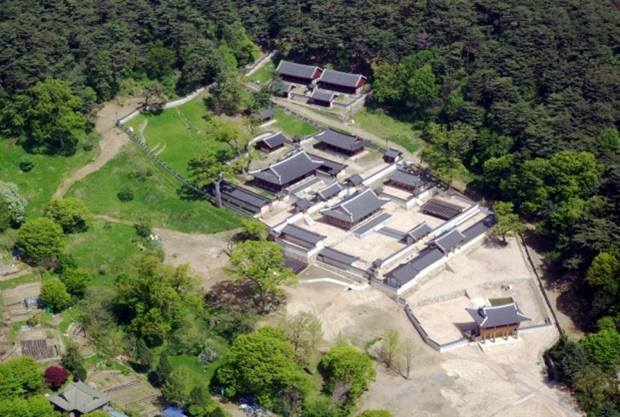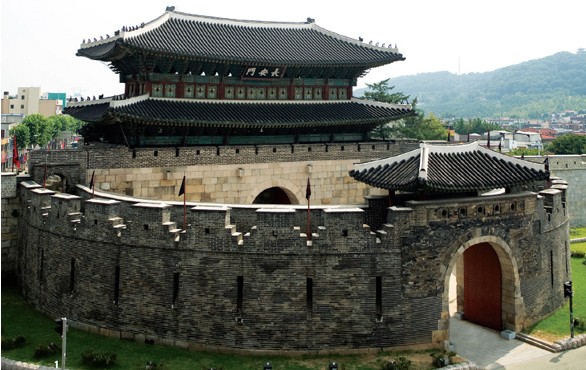Situated 25km southeast from the center of the capital city of Seoul, the mountain fortress city of Namhansanseong sits approximately 480m above sea level aligning itself with the ridges of the mountain to maximize its defensive capacity. The fortress encompassing 12km in length protects a vast area utilized as an emergency capital city of the Joseon Dynasty of Korea (1392~1910). With the basis of fortress architecture of East Asia, the fortress embodies the broad exchange between the four countries: Joseon of Korea, Azuchi-Momoyama Period of Japan, Ming and Qing China, especially in the 16th~18th centuries through the continuous wars. The technical development of weaponry and armaments during this period which saw the use of gun powder in military warfare imported from Europe also greatly influenced the architecture and layout of the fortress. Namhansanseong portrays how the various theories of defense mechanisms in Korea were put to form by combining the everyday living environment with defense objectives, embodies the evidence of how Buddhism played an influential role in protecting the State and the fortress became a symbol of sovereignty in Korea. It stands on the Namhansan ("South Han Mountain"), containing fortifications that date back to the 17th century, and a number of temples. It can be accessed easily from Seoul through Namhansanseong Station of Seoul Subway Line 8.
History
The most obvious characteristic of Namhansanseong lies in its topographical advantage; a spacious flat top called Gorobong, with a low center and high sides over 480m above sea level, as well as being a high mountain over flat lands to easily observe around. Due to such a topographical advantage, Namhansanseong served as a commanding post since the Unified Silla era in the 7th century. Unified Silla constructed Jujangseong fortress where Namhansanseong sits today, to raise men and to stock supplies when it was carrying out the war against the Tang Dynasty in the 7th century. In the 13th century during Goryeo Dynasty, Namhansanseong was a stronghold against the Mongol Invasion. Since the 17th century, Namhansanseong, near the capital city of Seoul, evolved greatly in its size as a mountain fortress, serving as an emergency capital for the King of Joseon to take refuge in emergencies. Consequently, it became a super-sized mountain fortress, the likeness of which is rarely found anywhere else in the world.
Furthermore, Namhansanseong had been systematically managed and operated for over 300 years since its construction in 1624. Specifically, it was the historical battlefield of the second Manchu Invasion to acquire hegemony in East Asia during the Ming-Qing dynasty transition in 1636. It was the spiritual symbol of the Joseon dynasty for sovereignty, as well as a place for military security until the 20th century. The rich history of Namhansanseong shows the exchange of Buddhist, Confucian, folk religion and Christian values from the time the fortress was constructed to the present day.
The 17th century mountain fortress Namhansanseong was constructed as a planned city both to serve as an emergency capital city during wartimes and an administrative center in normal times. Common traditional villages are typically located on flat lands adjacent to mountain fortress built for shelter in emergencies. Namhansanseong was a self-sufficient defensive fortress where the local administrative town was placed within the fortress together with the Emergency Palace. Thus, it performed various functions such as defense, administration, business and royal ancestral rites. Unlike those seen in Europe and Japan that were intended to defend only the ruling class, Namhansanseong was a defensive structure within which both the ruling class and the commoners alike could take shelter.
Since the 17th century, Namhansanseong has been dominantly inhabited with over 4,000 in population and has been managed and preserved by the residents for generations. Most fortress towns in Korea underwent severe deformation and change from the Japanese colonial times and the period going through the process of industrialization and urbanization, resulting in losing their original layout and forms, but Namhansanseong retained its original layout because the Japanese colonial government relocated the administrative functions and demolished its military functions in the earlier stage of colonization, leaving it as an isolated mountain village thereafter.
The characteristics of Namhansanseong have changed a lot throughout the course of history. The fortress served as a military and administrative center with the Emergency Palace and administrative office from 1627 to 1917. It was the center of the civil resistance movement (Uibyeong) centering on Buddhist monk soldiers temples (Seungyeong) when the Joseon Dynasty fell and the Japanese colonial period was approaching in the early 20th century. However, the fortress experienced demolition and the temples were forced into closure by the Japanese in 1907. The fortress lost its function as the town center due to the relocation of the Gwangju County Office in 1917, resulting in a downgrade to a remote mountain village. Then, the fortress suffered population loss and material loss during the Korean War. Nowadays Namhansanseong has become a tourist attraction point in the vicinity of Seoul, after undergoing large-scale wall restorations and being designated as a provincial park since the 1970s. It has seen a dramatic increase in the number of restaurants and various visitor facilities since the 1980s. The Emergency Palace and the Royal Ancestral Shrine within the fortress have been actively restored based on various studies on Namhansanseong since the 1990s, and it was enlisted on the World Heritage tentative list in 2010. It was inscribed on the UNESCO World Heritage list in 2014.













